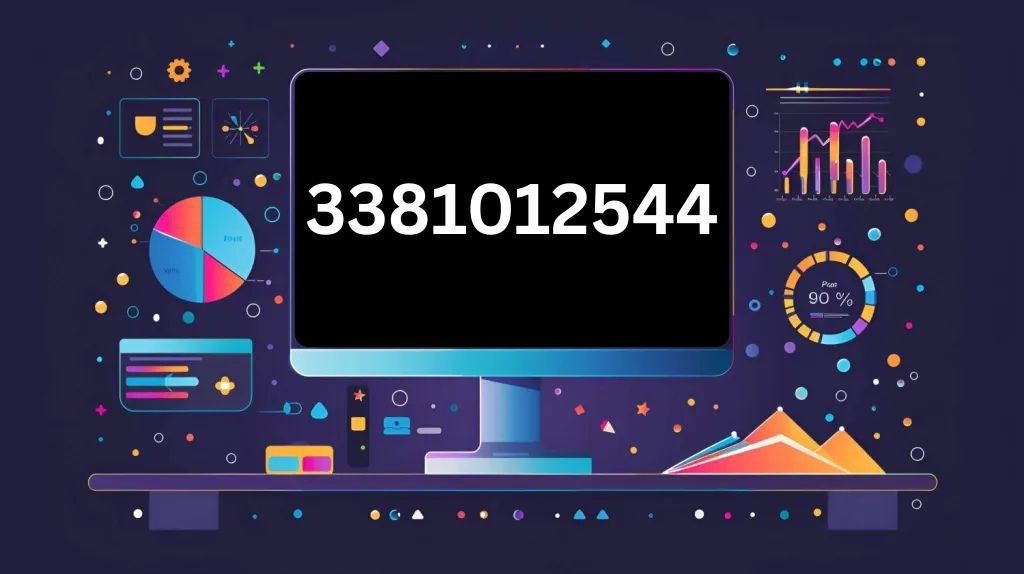Numbers often serve purposes beyond simple counting. They can act as identifiers, unique references, or codes that unlock specific meanings in different contexts. Among these, 3381012544 stands out as a sequence worth examining due to its potential role in digital systems, organizational tracking, and structured data management. By breaking down what a number like 3381012544 represents, how it can be applied, and why it matters, we can appreciate its importance in both professional and practical scenarios.
The Role of Unique Identifiers in Modern Systems
Every organized system, whether digital or physical, depends on identifiers. These identifiers may be numeric, alphanumeric, or symbolic, but they share one function distinguishing one entity from another. 3381012544 can be seen as such an identifier. It could represent a customer profile, a shipment number, a digital code, or even an internal reference for a company’s database.
The strength of identifiers like 3381012544 lies in their precision. Unlike names or words, which can be duplicated, numeric sequences remain unique when properly generated and assigned. This uniqueness makes them indispensable for tracking, categorizing, and ensuring accuracy in operations.
Why Long Numeric Codes Are Reliable
Numbers like 3381012544 are not random; they often follow a systematic structure. Long numeric codes are less prone to duplication and errors compared to shorter ones. The more digits in a code, the lower the chance of accidental overlap. For example:
Security Systems: Long identifiers ensure access codes are difficult to guess.
Data Storage: Databases rely on extended numbers to create unique entries.
Business Operations: Companies use long numbers to prevent duplication in billing, tracking, or inventory systems.
In this sense, 3381012544 can be regarded as a reliable digital marker, offering both uniqueness and clarity within a structured framework.
Breaking Down the Sequence 3381012544
Looking closely, 3381012544 consists of ten digits. This makes it large enough to represent a vast range of possibilities while still being manageable for record-keeping. Each section of the number could theoretically correspond to categories or divisions, depending on the system that uses it.
For example:
-
The first three digits (338) may represent a category or region.
-
The middle section (1012) may define a department, process, or group.
-
The last three digits (544) could act as a unique reference for an item or person.
This segmentation approach demonstrates how numbers like 3381012544 can carry layered meanings while appearing simple on the surface.
Applications of 3381012544 in Daily Contexts
Business and Inventory Management
Businesses often rely on long numeric identifiers to organize their stock, shipments, or invoices. A code such as 3381012544 could represent a product, ensuring it is not confused with similar items. This practice enhances traceability and reduces the risk of mismanagement.
Digital Record Systems
Healthcare, banking, and government agencies frequently assign numbers to individuals or documents. In such cases, 3381012544 might correspond to a record entry that ensures secure handling of sensitive data.
Communication and Technology
In digital communication systems, identifiers like 3381012544 could serve as tracking numbers for support tickets, authentication processes, or system logs. These uses strengthen accountability and ensure that no query or record is lost in large-scale operations.
The Importance of Consistency in Numeric Identifiers
A key strength of a number like 3381012544 lies in its ability to remain consistent across platforms. Whether entered into a computer, printed on a receipt, or stored in a file, the number retains its meaning without distortion.
Consistency ensures:
-
Accuracy: Mistakes are minimized when every record points to one unique number.
-
Reliability: Systems can quickly verify data using the identifier.
-
Scalability: Large organizations can handle millions of records without overlap.
How Numbers Like 3381012544 Improve Efficiency
Efficiency in modern systems often depends on speed and accuracy. Using identifiers such as 3381012544, processes become streamlined. For example:
-
In logistics, shipments can be tracked instantly by scanning or entering the code.
-
In customer service, support teams can quickly access the right profile using the number.
-
In technical systems, databases retrieve the correct data set without delays.
This shows how numbers act as silent drivers of smooth, fast, and error-free operations.
Security Aspects of Long Codes
Another important consideration is security. Codes like 3381012544 enhance protection against unauthorized access. A shorter number may be easier to guess or misuse, but a longer one creates complexity. Systems that handle sensitive information often prefer such long identifiers.
Moreover, when combined with encryption or multi-layered verification, 3381012544 becomes part of a security mechanism that keeps information safe from breaches.
Human Interaction with Identifiers Like 3381012544
While machines and systems primarily handle identifiers, humans also interact with them. For instance, a customer might receive 3381012544 as a reference for their order. In such cases, the number serves as a bridge between technology and personal interaction, giving people confidence that their query, request, or purchase is being tracked.
The memorability of numbers may vary, but structured identifiers often make processes smoother for both organizations and individuals.
Potential Challenges in Handling Long Numbers
Although useful, identifiers such as 3381012544 can pose certain challenges:
-
Input Errors: Typing mistakes may lead to incorrect records.
-
Miscommunication: Sharing long numbers verbally can sometimes cause confusion.
-
Storage Requirements: Systems need to handle large volumes of long numbers without slowing down.
Addressing these challenges involves user-friendly design, error detection mechanisms, and advanced database optimization.
Future Outlook for Identifiers Like 3381012544
As systems grow more complex, reliance on identifiers will increase. Numbers like 3381012544 may become part of larger integrated frameworks that connect businesses, governments, and individuals.
With digital transformation advancing rapidly, identifiers will likely evolve into hybrid codes—mixing numbers with additional layers such as checksums, encryption, or smart tags. Yet, the principle of unique numeric representation will remain vital.
Frequently Asked Questions
Q1: Why is 3381012544 important?
It represents the idea of unique numeric identifiers that ensure precision, organization, and reliability across different systems.
Q2: Can 3381012544 be linked to personal information?
Not inherently. It is a neutral identifier that gains meaning only when assigned within a specific context such as business, healthcare, or logistics.
Q3: How does 3381012544 improve efficiency?
By providing a consistent and error-free way to track, retrieve, and verify information in both manual and automated systems.
Q4: Is 3381012544 secure?
On its own, it is just a number. However, when used within encrypted or authenticated frameworks, it contributes to secure data handling.
Q5: Will identifiers like 3381012544 remain relevant in the future?
Yes, as digital systems expand, unique numeric identifiers will continue to play an essential role in data organization and communication.
Read Also: 3381012544: Its Meaning, Uses, Pros & Cons
Conclusion
Numbers like 3381012544 highlight the strength of structured identifiers in modern systems. They ensure order, efficiency, and security in contexts ranging from business operations to digital record management. While the sequence itself is neutral, its application demonstrates how simple numeric codes can support vast and complex infrastructures.
In a world driven by information and precision, identifiers such as 3381012544 are not just strings of digits—they are tools of organization, trust, and efficiency that shape the way systems function today and into the future.

